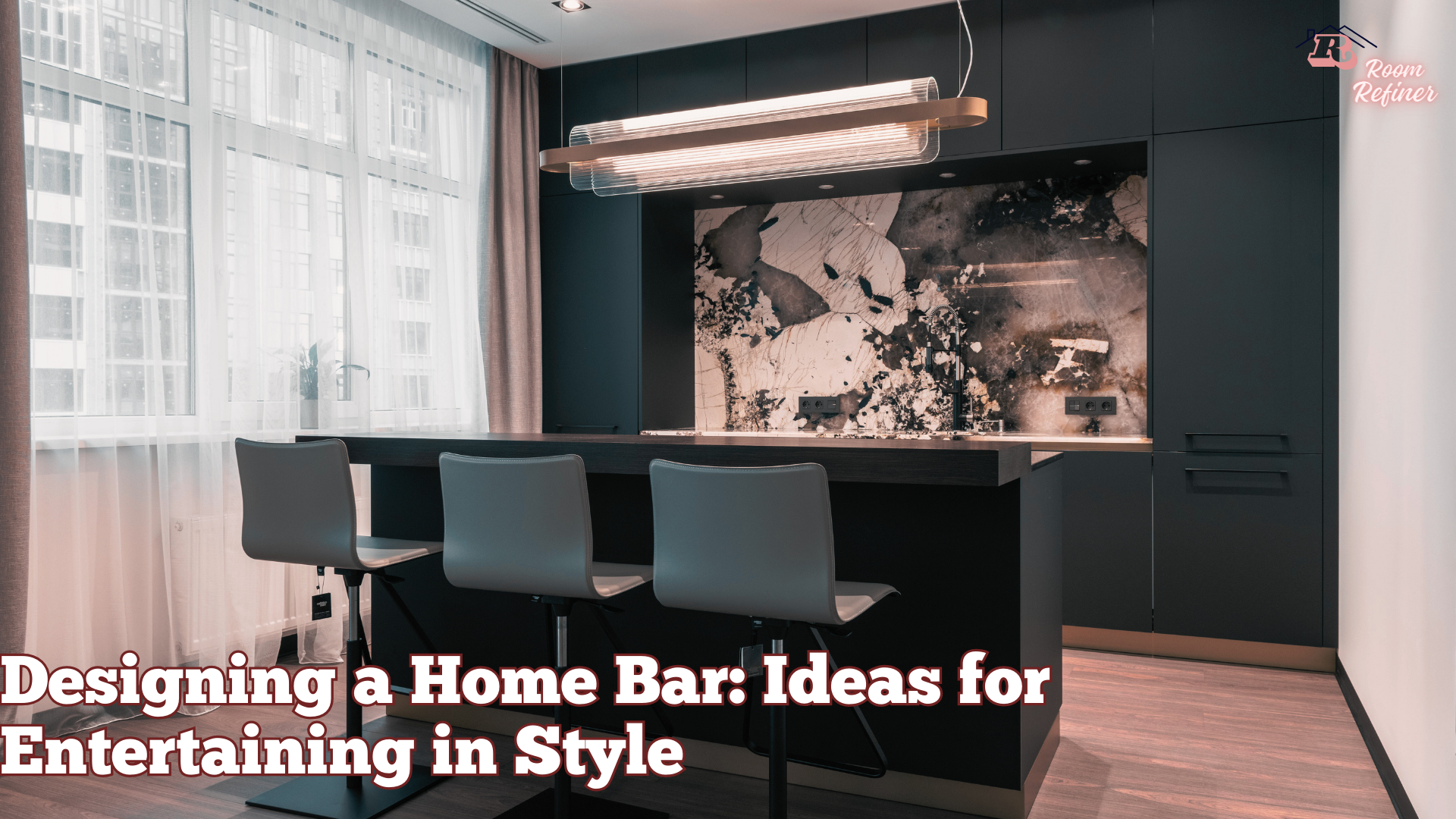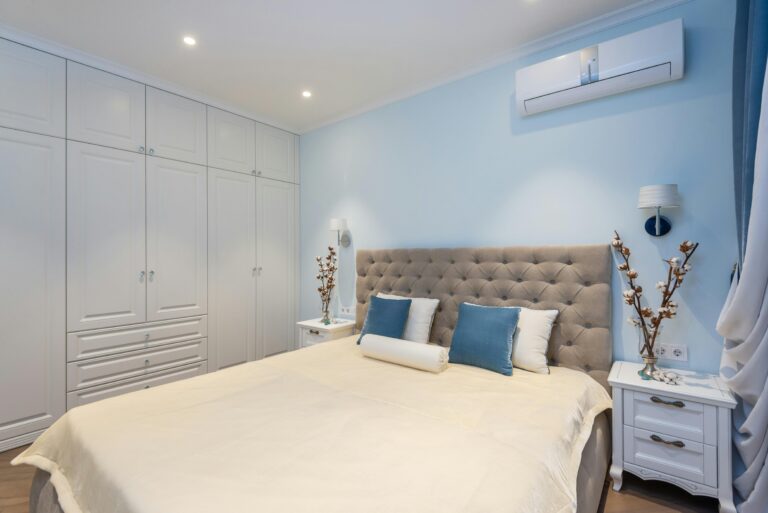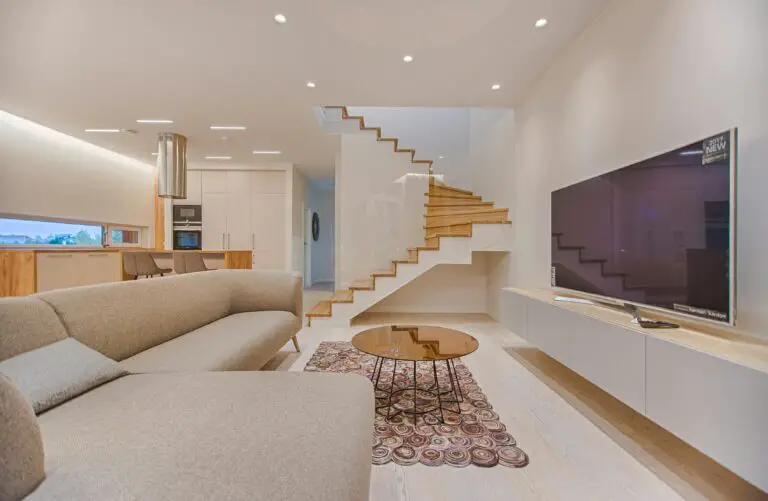The allure of having a home bar has grown significantly in recent years, and for good reason. A well-designed home bar is not just a place to mix drinks; it’s a hub of entertainment, a gathering spot for friends and family, and a statement of your personal style.
In this comprehensive guide, we’ll explore creative ideas and expert tips for crafting a home bar that exudes style and sophistication.
The Growing Trend of Home Bars
The concept of a home bar has evolved from a niche interest to a mainstream trend. More homeowners are realizing the benefits of having a dedicated space for entertainment, relaxation, and showcasing their mixology skills.
Stylish home entertainment is about creating memorable experiences for your guests and enjoying the pleasures of leisure in the comfort of your own home. A well-designed home bar enhances your ability to entertain in a way that is both enjoyable and impressive.
Designing a home bar involves careful planning, attention to detail, and a dash of creativity. Whether you have a dedicated room or a small corner to work with, we’ll guide you through every step of the process, from choosing the right location to selecting the perfect decor.
Choosing the Right Location
1. Evaluating Available Space
The first step in designing a home bar is to assess your available space. Consider underutilized areas like a basement, spare room, or even a nook under the stairs. The size and layout of your space will influence your bar’s design.
2. Considering Traffic Flow
Think about how guests will move around the bar area. Ensure there’s enough space for people to sit or stand comfortably without feeling cramped. Easy access to the bar counter is essential for a smooth flow of service.
3. Indoor vs. Outdoor Home Bars
Decide whether you want your home bar to be indoors or outdoors. Indoor bars offer climate control and year-round use, while outdoor bars provide a fresh, al fresco experience. Your choice will dictate the materials, furnishings, and design considerations.
Home Bar Design Styles
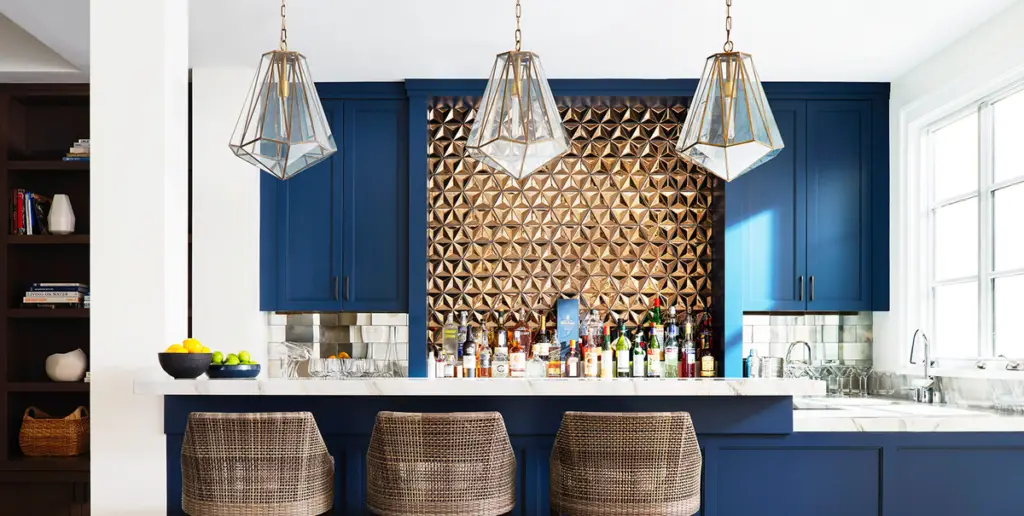
1. Classic and Traditional
Classic home bars exude timeless elegance, often featuring rich wood finishes, ornate details, and baroque-inspired decor. Dark mahogany or cherry wood is commonly used, creating a warm and inviting ambiance.
2. Modern and Minimalist
Modern home bars embrace simplicity and clean lines. Sleek materials like glass and metal, paired with minimalistic furnishings, create a contemporary look. Monochromatic color schemes and minimalist barware complete the style.
3. Tiki or Tropical
Tiki or tropical home bars transport you to a beachfront paradise. Bamboo and rattan furniture, tiki masks, and vibrant, exotic colors dominate the decor. Tiki bars are known for their playful and laid-back atmosphere.
4. Industrial and Rustic
Industrial and rustic home bars combine raw materials like reclaimed wood, exposed brick, and metal accents. This style often features open shelving, vintage barstools, and a warehouse-inspired aesthetic.
Essential Home Bar Elements
1. Bar Counter and Backsplash
The bar counter is the centerpiece of your home bar. Choose materials and finishes that match your chosen style. Granite, marble, and wood are popular choices. A stylish backsplash can add character and protection to the wall behind the counter.
2. Shelving and Storage
Ample storage is crucial for a well-organized bar. Install open shelves to display your liquor collection and glassware. Closed cabinets can hide clutter and provide a neat appearance.
3. Seating Options
Select comfortable seating that complements the design of your home bar. Barstools come in various styles, from traditional to contemporary. Consider swivel stools for added convenience.
4. Lighting Fixtures
Lighting fixtures play a vital role in setting the mood of your home bar. Pendant lights, track lighting, or even a dazzling chandelier can illuminate the bar area and enhance its visual appeal.
5. Beverage Selection
Stock your home bar with a well-curated selection of beverages. Include a variety of spirits, mixers, and garnishes to cater to different tastes. Display your collection attractively on the bar counter or shelving.
Designing the Bar Counter
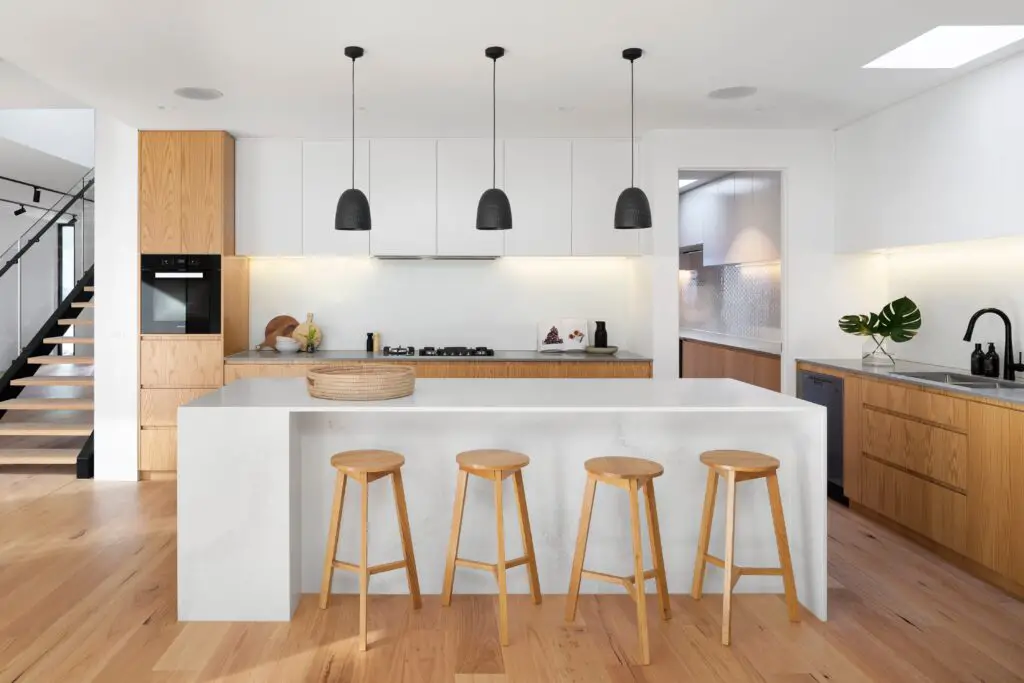
1. Materials and Finishes
The choice of materials and finishes for your bar counter is a significant design decision. Wood counters exude warmth, while granite or quartz adds a touch of luxury. The finish should align with your chosen style, whether it’s glossy for modern or distressed for rustic.
2. Bar Top Styles
Bar counters can have various top styles, from straight-edged to curved or irregular shapes. The style should complement the overall design and flow seamlessly with the surrounding space.
3. Backsplash and Accent Details
A well-designed backsplash can elevate the aesthetics of your bar counter. Consider tiles, mirrored glass, or decorative panels. Accent details like corbels, brackets, and trim can add character and charm.
Home Bar Decor
1. Wall Art and Decorative Items
Enhance the ambiance of your home bar with wall art and decorative items. Framed vintage posters, cocktail-themed artwork, and even a gallery wall of your favorite spirits can create a personalized and engaging atmosphere.
2. Glassware and Barware
Display your glassware and barware as both functional tools and decorative elements. Crystal decanters, cocktail shakers, and unique glassware designs can be showcased on open shelving or within glass cabinets.
3. Personalized Touches
Add personalized touches to your home bar with custom signs, coasters, or monogrammed napkins. These small details make your bar feel uniquely yours and add a personal touch to your entertaining space.
Maximizing Functionality of Home Bars
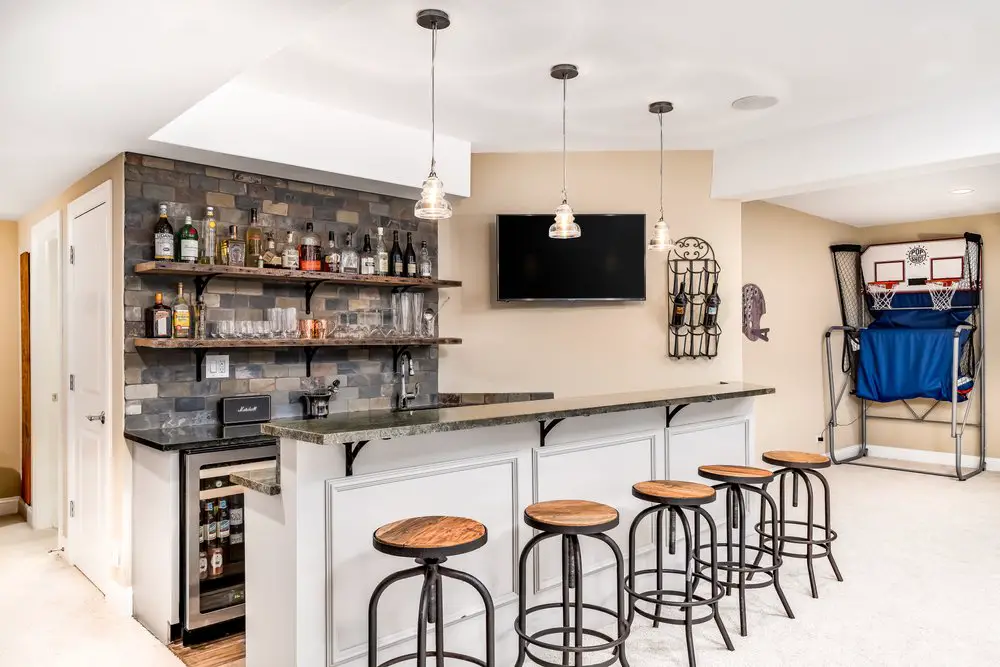
1. Organization and Storage Solutions
Efficient organization is key to a functional home bar. Use storage solutions like adjustable shelves, built-in wine racks, and pull-out drawers to keep everything in its place.
2. Bartender’s Tools and Accessories
Invest in quality bartender’s tools and accessories. Essential items include jiggers, muddlers, strainers, and cocktail spoons. Having the right tools on hand ensures smooth drink preparation.
3. Sound and Entertainment Systems
Enhance the entertainment value of your home bar with a sound system. Consider installing speakers or a surround sound system for music or home theater experiences. A television or projector can also be integrated for sports events or movie nights.
Home Bar Accessories
1. Cocktail Shakers and Mixing Tools
Cocktail shakers, mixing glasses, and stirring spoons are essential for crafting cocktails. Invest in high-quality tools that not only perform well but also look stylish on your bar counter.
2. Glass Racks and Wine Storage
If you’re a wine enthusiast, incorporate glass racks and wine storage into your home bar design. Wine bottles can be stored horizontally to maintain optimal cork moisture.
3. Bar Stools and Seating
Choose bar stools that align with your chosen style and provide comfort for guests. Swivel stools are a practical choice, allowing easy movement and interaction around the bar.
Creating a Home Bar Menu
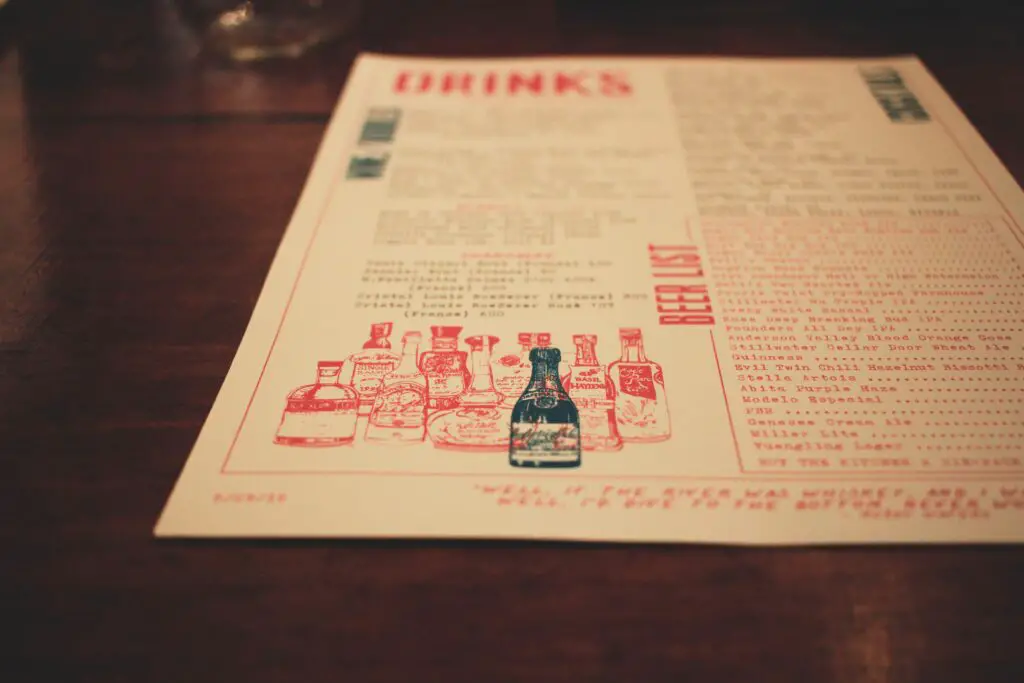
1. Signature Cocktails
Create a selection of signature cocktails that reflect your taste and style. Include a variety of drinks, from classic cocktails to unique creations. Display the menu on a chalkboard or framed print for guests to peruse.
2. Beverage Selection and Presentation
Stock your bar with a diverse range of beverages to cater to different preferences. Arrange bottles and glassware attractively on the bar counter. Use garnishes and stylish drinkware to enhance the presentation.
3. Non-Alcoholic Options
Don’t forget to provide non-alcoholic options for guests who prefer not to drink alcohol. Include a variety of mocktail recipes and ingredients so everyone can enjoy the bar experience.
Maintenance and Care
1. Cleaning and Upkeep
Regular cleaning and upkeep are essential to keep your home bar looking its best. Wipe down counters, shelves, and glassware regularly to prevent dust and residue buildup.
2. Restocking and Inventory Management
Monitor your liquor inventory and restock as needed. Keep track of expiration dates and dispose of any expired products. Proper inventory management ensures you’re always ready to serve your favorite drinks.
3. Responsible Hosting Practices
As a host, it’s crucial to practice responsible alcohol service. Be mindful of your guests’ alcohol consumption, provide alternative transportation options if needed, and ensure everyone’s safety.
Conclusion
Designing a home bar is a rewarding endeavor that combines aesthetics, entertainment, and hospitality. By carefully considering space, style, and essential elements, you can create a home bar that not only stands out but also becomes the heart of your entertainment.
We hope this comprehensive guide has inspired you to embark on your home bar design journey, elevating your entertaining experiences and allowing you to celebrate life’s moments in style.
Frequently Asked Questions
1. How do I make my home bar stand out?
To make your home bar stand out, focus on unique design elements such as a distinctive bar counter, creative decor, and personalized touches. Choose a style that resonates with your personality and preferences.
2. How to decorate a bar for a party?
Decorate your bar for a party by incorporating themed decorations, lighting, and a well-curated drink menu. Consider adding party-specific decor like banners, balloons, and tableware to enhance the festive atmosphere.
3. How do you style a living room bar?
To style a living room bar, select a design that complements your living room’s decor. Use cohesive color schemes and decor elements to seamlessly integrate the bar into the space. Consider adding comfortable seating and decorative accents.
4. What is the best color for a bar top?
The best color for a bar top depends on your design style and preferences. Dark wood finishes exude warmth, while marble or granite tops offer a luxurious touch. Choose a color that complements your overall home bar design.
5. How can I make my bar look nice?
To make your bar look nice, focus on design cohesion, cleanliness, and organization. Choose stylish decor, keep the bar area clean and well-maintained, and ensure that your glassware and spirits are neatly displayed.
6. What is the best shape for a bar?
The best shape for a bar depends on your available space and design vision. Common bar shapes include straight bars, L-shaped bars, and curved bars. Choose a shape that fits comfortably within your designated bar area.
7. What are the two elements to be considered when designing a bar?
When designing a bar, two essential elements to consider are functionality and aesthetics. The bar should be designed to efficiently serve drinks and entertain guests while reflecting your personal style and design preferences.
8. What are the qualities of a good bar?
A good bar should have qualities such as an inviting atmosphere, a well-stocked liquor selection, professional-grade bartending tools, comfortable seating, and a thoughtful drink menu. It should also adhere to responsible alcohol service practices.
9. What are the 5 parts of the bar?
The five parts of a bar include the bar counter, seating area, shelving and storage, lighting fixtures, and decor. These components work together to create a functional and visually appealing bar space.
10. How do you plan a bar?
Planning a bar involves assessing available space, determining your design style, selecting essential elements, and considering the practical aspects of bartending. Create a layout, choose materials and finishes, and plan for storage and organization.
11. What goes behind a bar?
Behind a bar, you typically find storage for liquor bottles, mixers, and barware. You may also find bartending tools, sinks for washing glassware, and refrigeration units for perishable ingredients. The layout depends on the size and design of the bar.
